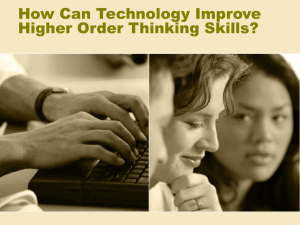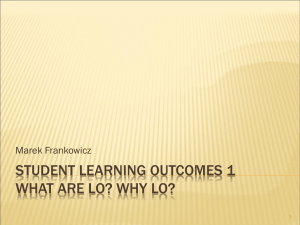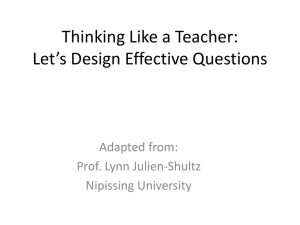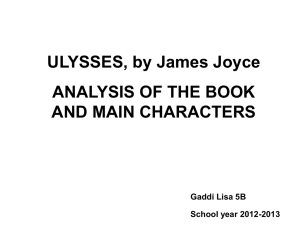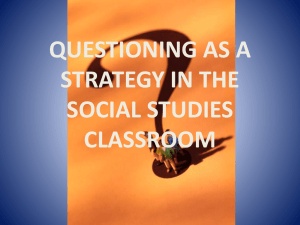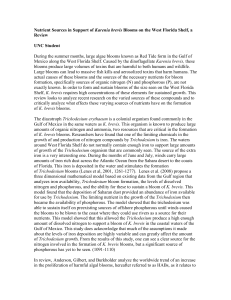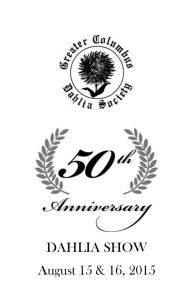Bloom`s experiment form
advertisement
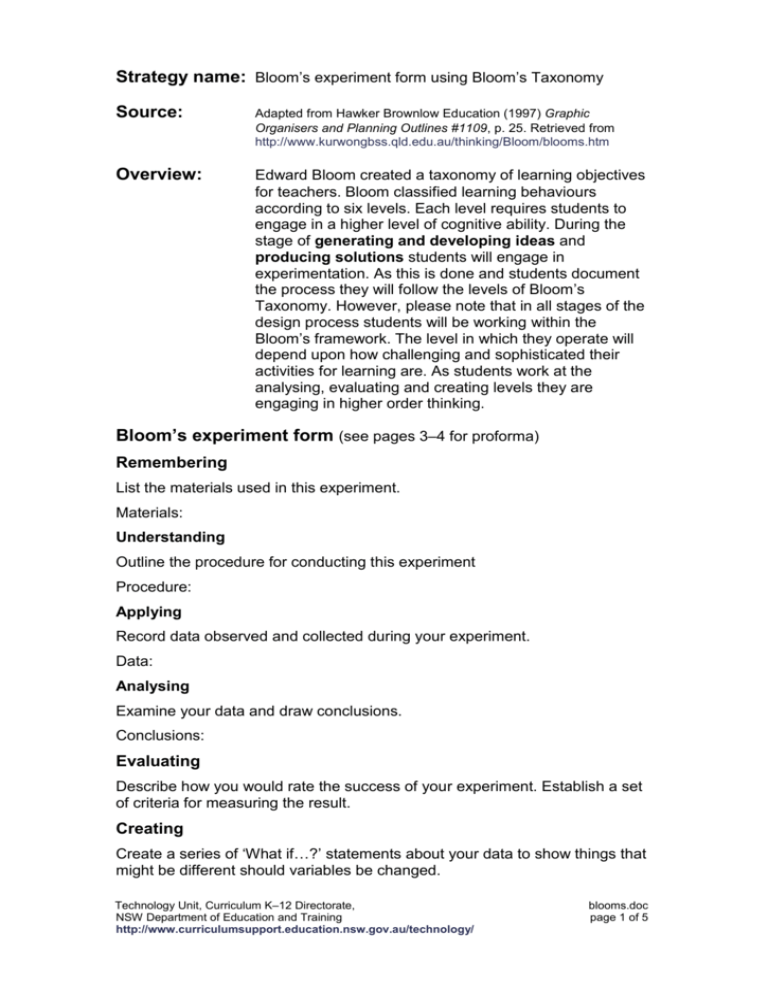
Strategy name: Bloom’s experiment form using Bloom’s Taxonomy Source: Adapted from Hawker Brownlow Education (1997) Graphic Organisers and Planning Outlines #1109, p. 25. Retrieved from http://www.kurwongbss.qld.edu.au/thinking/Bloom/blooms.htm Overview: Edward Bloom created a taxonomy of learning objectives for teachers. Bloom classified learning behaviours according to six levels. Each level requires students to engage in a higher level of cognitive ability. During the stage of generating and developing ideas and producing solutions students will engage in experimentation. As this is done and students document the process they will follow the levels of Bloom’s Taxonomy. However, please note that in all stages of the design process students will be working within the Bloom’s framework. The level in which they operate will depend upon how challenging and sophisticated their activities for learning are. As students work at the analysing, evaluating and creating levels they are engaging in higher order thinking. Bloom’s experiment form (see pages 3–4 for proforma) Remembering List the materials used in this experiment. Materials: Understanding Outline the procedure for conducting this experiment Procedure: Applying Record data observed and collected during your experiment. Data: Analysing Examine your data and draw conclusions. Conclusions: Evaluating Describe how you would rate the success of your experiment. Establish a set of criteria for measuring the result. Creating Create a series of ‘What if…?’ statements about your data to show things that might be different should variables be changed. Technology Unit, Curriculum K–12 Directorate, NSW Department of Education and Training http://www.curriculumsupport.education.nsw.gov.au/technology/ blooms.doc page 1 of 5 Using Bloom’s experiment form for generating and developing ideas 1. Before using the Bloom’s experiment form, ask the class to list and discuss the questions you would like answered by the experimentation. 2. Ask students to predict experiment results. 3. Carry out the experimentation using the Bloom’s experiment form for recording. 4. Ask students to determine the most important facts they learnt from the experiment. Students can then rank the information from most important to least important, giving reasons for their choices (evaluating). Technology Unit, Curriculum K–12 Directorate, NSW Department of Education and Training http://www.curriculumsupport.education.nsw.gov.au/technology/ blooms.doc page 2 of 5 Bloom’s experiment form Remembering List the materials used in this experiment. Materials:______________________________________________________ ______________________________________________________________ Understanding Outline the procedure for conducting this experiment. Procedure: 1. _______________________________________________________ 2. _______________________________________________________ 3. _______________________________________________________ 4. _______________________________________________________ 5. _______________________________________________________ Applying Record data observed and collected during your experiment. Data: What I did What I observed Analysing Examine your data and draw conclusions. Conclusions: 1.____________________________________________________________ ______________________________________________________________ 2.____________________________________________________________ ______________________________________________________________ 3.____________________________________________________________ ______________________________________________________________ Technology Unit, Curriculum K–12 Directorate, NSW Department of Education and Training http://www.curriculumsupport.education.nsw.gov.au/technology/ blooms.doc page 3 of 5 Evaluating Describe how you would rate the success of your experiment. Establish a set of criteria for measuring the result. ______________________________________________________________ ______________________________________________________________ Creating Create a series of ‘What if…?’ statements about your data to show things that might be different should variables be changed. What if… ______________________________________________________ What if… ______________________________________________________ Adapted from Hawker Brownlow Education (1997) Graphic Organisers and Planning Outlines #1109, p. 25. Retrieved from http://www.kurwongbss.qld.edu.au/thinking/Bloom/blooms.htm Technology Unit, Curriculum K–12 Directorate, NSW Department of Education and Training http://www.curriculumsupport.education.nsw.gov.au/technology/ blooms.doc page 4 of 5 Background information Bloom’s Revised Taxonomy Remembering: recalling information recognising, listing, describing, retrieving, naming, finding Understanding: explaining ideas or concepts interpreting, summarising, inferring, classifying, explaining Applying: using the new knowledge in another situation implementing, carrying out, using Analysing: breaking down, differentiating between the parts, connecting and organising information comparing, organising, deconstructing Evaluating: justifying a decision or course of action checking, judging, hypothesising, critiquing Creating: generating new ways of viewing things, generating new ideas, generating new products designing, constructing, planning, producing, inventing Activities related to each level of Bloom’s Taxonomy Remembering Making a timeline, making a list of main events, making a facts chart etc. Understanding Drawing pictures or finding pictures to highlight an event, developing a cartoon strip to show an event sequence, preparing a flow chart Applying Making a scrapbook about the topic/area of study, constructing a model/prototype to demonstrate how an idea will work, writing a manual Analysing Designing a survey to gather information, constructing a graph to show certain information, comparing/contrasting charts Evaluating Preparing a case to present a point of view, preparing a list of criteria to judge a project, conducting a debate Synthesising Creating a new product, selling an idea, planning a marketing campaign. Technology Unit, Curriculum K–12 Directorate, NSW Department of Education and Training http://www.curriculumsupport.education.nsw.gov.au/technology/ blooms.doc page 5 of 5



